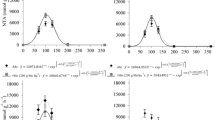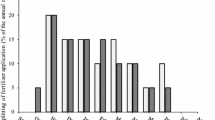Abstract
The aim of this study was to evaluate the response of sugarcane to nitrogen (N) application with drip irrigation and the relation with carbon isotope discrimination (Δ13C), aboveground dry matter cane yield and the N balance in consecutive ratoon crops of sugarcane. An experiment was set up in Jaú, SP, Brazil, in which the second and third ratoon crop cycles (2008/2009 and 2009/2010) were evaluated. The experiment included an unfertilized N control in both years (T1), and the following three nitrogen (N) fertilizer rates (in kg ha−1) applied in 2008 and 2009, respectively: 70 and 50 (T2), 140 and 100 (T3), and 210 and 150 (T4). Fertilization with N caused a marked gain in stalk yields by 98 Mg ha−1 in 2 years. The N export with harvest was higher than N application in the control treatment T1 and at the lower rate (T2); this, in addition to the observed linear response to N, indicate the need to increase N fertilization in irrigated sugarcane. The values of Δ13C decreased with the increase of N supply showing a significant negative correlation (p < 0.05) with stalk as well as whole plant aboveground dry matter yields. The values of Δ13C in top leaves may be used as a tool to characterize the N status of sugarcane plants and its relation to aboveground dry matter and yield.







Similar content being viewed by others
References
AQUASTAT (FAO’s Information System on Water and Agriculture). 2014. Brazil: Geography and population. Available from: http://www.fao.org/nr/water/aquastat/countries_regions/bra/index.stm. Accessed 05 May 2014.
Arruda, P. 2012. Genetically modified sugarcane for bioenergy generation. Current Opinion Biotechnology 23: 315–322. doi:10.1016/j.copbio.2011.10.012.
Barrie, A., and S.J. Prosser. 1996. Automated analysis of light-element stable isotopes by isotope ratio mass spectrometry. In Mass spectrometry of soils, ed. T.W. Boutton, and S. Yamasaki, 1–46. New York: Marcel Dekker.
Bell, M.J., and A.L. Garside. 2014. Growth and yield responses to amending the sugarcane monoculture: interactions between break history and nitrogen fertilizer. Crop & Pasture Science 60: 287–299. doi:10.1071/CP13340.
Cernusak, L.A., N. Ubierna, K. Winter, J.A.M. Holtum, J.D. Marshall, and G.D. Farquhar. 2013. Environmental and physiological determinants of carbon isotope discrimination in terrestrial plants. New Phytologist 200: 950–965. doi:10.1111/nph.12423.
Carnaúba, B.A.A. 1990. O nitrogênio e a cana-de-açúcar. STAB-Açúcar, Álcool e Subprodutos 8: 4–41.
Chapola, R.G., H.P. Hoffmann, A.I. Bassinello, A.R. Fernandes Jr, and M.A.S. Vieira. 2011. Censo varietal 2010 de cana-de-açúcar nos estados de São Paulo e Mato Grosso do sul. STAB-Açúcar, e Álcool e Subprodutos 29: 42–45.
Clay, D.E., S.A. Clay, Z. Liu, and C. Reese. 2001. Spatial variability of C-13 isotopic discrimination in corn (Zea mays). Communications Agronomy Journal 32: 1813–1827. doi:10.2134/agronj2005.0066.
Dalri, A.B., and R.L. Cruz. 2008. Produtividade da cana-de-açúcar fertirrigada com N e K via gotejamento subsuperficial. Engenharia Agrícola 28: 516–524. doi:10.1590/S0100-69162008000300012.
Dourado Neto, D., D.S. Powlson, R.A. Bakar, O.O.S. Bacchi, M.V. Basanta, P.T. Cong, G. Keerthisinghe, M. Ismaili, S.M. Rahman, K. Reichardt, M.S.A. Safwat, R. Sangakkara, L.C. Timm, and J.Y. Wang. 2010. Multiseason recoveries of organic and inorganic nitrogen-15 in tropical cropping systems. Soil Science Society of America Journal 74: 139–152. doi:10.2136/sssaj2009.0192.
EMBRAPA. 2006. CNPS—Centro Nacional de Pesquisa de Solos—Manual de métodos de análises de solo, 2nd ed. Rio de Janeiro, RJ: Embrapa.
EMBRAPA. 2013. CNPS—Centro Nacional de Pesquisa de Solos. Sistema brasileiro de classificação de solos. Rio de Janeiro, RJ: Embrapa.
Epstein, E., and A.J. Bloom. 2004. Mineral nutrition of plants: Principles and perspectives, 2nd ed. Sunderland, MA: Sinauer Associates.
Farquhar, G.D. 1983. On the nature of carbon isotope discrimination in C4 species. Australian Journal Plant Physiology 10: 205–226.
Fernandes, A.C. 2003. Calculated on the ethanol plant cane. 2nd ed. STAB. Açúcar, Álcool e Subprodutos. Piracicaba, SP.
Fortes, C., P.C.O. Trivelin, and A.C. Vitti. 2012. Long-term decomposition of sugarcane harvest residues in Sao Paulo state, Brazil. Biomass and Bioenergy 42: 189–198. doi:10.1016/j.biombioe.2012.03.011.
Franco, H.C.J., R. Otto, C.E. Faroni, A.C. Vitti, E.C.A. Oliveira, and P.C.O. Trivelin. 2011. Nitrogen in sugarcane derived from fertilizer under Brazilian field conditions. Field Crops Research 121: 29–41. doi:10.1016/j.fcr.2010.11.011.
Franco, H.C.J., P.C.O. Trivelin, C.E. Faroni, A.C. Vitti, and R. Otto. 2010. Stalk yield and technological attributes of planted cane as related to nitrogen fertilization. Scientia Agricola 67: 579–590. doi:10.1590/S0103-90162010000500012.
Gava, G.J.C., M.A. Silva, R.C. Silva, E.M. Jerônimo, C.S. Cruz, and O.T. Kölln. 2011. Produtividade de três cultivares de cana-de-açúcar sob manejos de sequeiro e irrigado por gotejamento. Revista Brasileira Engenharia Agrícola & Ambiental 15: 250–255. doi:10.1590/S1415-43662011000300005.
Gunda, P., and H. Youngs. 2013. Bioenergy and Water: Understanding Impacts. MIT Energy Initiative and Center for Strategic International Studies. Energy Water Land Nexus Workshop. (May 6–7), 1–46. Washington, D.C.
Henderson, S.A., S.V. Caemmerer, and G.D. Farquhar. 1992. Short- term measurements of carbon isotope discrimination in several C4 species. Australian Journal Plant Physiology 19: 263–285.
Howell, T.A., and S.R. Evett. 2004. The Penman-Monteith method, 14. Washington, DC: USDA-Agricultural Research Service, Conservation & Production Research Laboratory.
Hubick, K.T., G.L. Hammer, G.D. Farquhar, L.J. Wade, S. Von Caemmerer, and S.A. Henderson. 1990. Carbon isotope discrimination varies genetically in C4 species. Journal Plant Physiology 91: 534–537. doi:10.1104/pp.92.2.534.
IBGE. 2006. Brazilian Institute of Geography and Statistics, 2006. Agricultural Census Survey. Available from http://www.ibge.gov.br/home/estatistica. Accessed 05 May 2014.
Korndörfer, G.H., M.R. Valle, M. Martins, and P.C.O. Trivelin. 1997. Utilization by planted cane of nitrogen from urea. Revista Brasileira de Ciência Solo 21: 23–26. doi:10.1590/S0100-06832008000700021.
Malavolta, E., G.C. Vitti, and S.A. Oliveira. 1997. Avaliação do estado nutricional das plantas: princípios e aplicações, 3rd ed. Potafos: Piracicaba, SP.
Meinzer, F.C., and J. Zhu. 1998. Nitrogen stress reduces the efficiency of the C4 CO2 concentrating system, and therefore quantum yield, in Saccharum (sugarcane) species. Journal Experimental Botany 49: 1227–1234. doi:10.1093/jxb/49.324.1227.
Monneveux, P., M.S. Sheshshayee, J. Akthter, and J.M. Ribaut. 2007. Using carbon isotope discrimination to select maize (Zea mays L.) inbred lines and hybrids for drought tolerance. Plant Science 173: 390–396. doi:10.1016/j.plantsci.2007.06.003.
Muchow, R.C., M.J. Robertson, and A.W. Wood. 1996. Growth of sugarcane under high input conditions in tropical Australia. II. Sucrose accumulation and commercial yield. Field Crops Research 48: 26–37. doi:10.1016/0378-4290(96)00042-1.
Ng Kee Kwong, K.F., J.P. Paul, and J. Deville. 1999. Drip-fertigation—a means for reducing fertilizer nitrogen to sugarcane. Experimental Agriculture 35: 31–37.
Oliveira, E.C.A., G.J. de Castro Gava, P.C.O. Trivelin, R. Otto, and H.C.J. Franco. 2013. Determining a critical nitrogen dilution curve for sugarcane. Journal Plant Nutrition and Soil Science 176: 712–723. doi:10.1002/jpln.201200133.
Pilbeam, C.J., and G.P. Warren. 1995. Use of 15 N for fertilizer N recovery an N mineralization studies in semiarid Kenya. Fertilizer Research 42: 123–128. doi:10.1007/BF00750506.
Van Raij, B., J.C. Andrade, H. Cantarella, and A.J. Quaggio (eds.). 2001. Análise química para avaliação da fertilidade de solos tropicais. Campinas, SP: IAC.
Rossetto, R., F.L.F. Dias, M.G.A. Landell, H. Cantarella, S. Tavares, A.C. Vitti, and D. Perecin. 2010. N and K fertilization of sugarcane ratoons harvested without burning. Proceedings of the International Society of Sugar Cane Technologists 27: 1–8.
Van Raij, B., and H. Cantarella. 1996. Outras culturas industriais. In Recomendações de adubação e calagem para o Estado de São Paulo, 2nd ed, ed. B. Van Raij, H. Cantarella, A.J. Quaggio, and A.M.C. Furlani, 8–13. Campinas, SP: IAC. (Boletim Técnico, 100).
Saliendra, N.Z., F.C. Meinzer, M. Perry, and M. Thom. 1996. Associations between partitioning of carboxylase activity and bundle sheath leakiness to CO2, carbon isotope discrimination, photosynthesis, and growth in sugarcane. Journal Experimental Botany 47: 907–914. doi:10.1093/jxb/47.7.907.
Singh, P.N., and S.C. Mohan. 1994. Water use and yield response of sugarcane under different irrigation schedules and nitrogen levels in a subtropical region. Agricultural Water Management 26: 253–264. doi:10.1016/0378-3774(94)90012-4.
Soil Survey Staff. 2010. Keys to soil taxonomy, 11th ed. Washington, DC: USDA-Natural Resources Conservation Service.
Stanley, C.D., R.E. Green, M.A. Khan, and L.T. Santo. 1990. Nitrogen fertilization rate on soil nitrate distribution for micro-irrigated sugarcane. Soil Science Society American Journal 54: 217–222.
Trivelin, P.C.O., H.C.J. Franco, R. Otto, D.A. Ferreira, A.C. Vitti, C. Fortes, C.E. Faroni, E.C.A. Oliveira, and H. Cantarella. 2013. Impact of sugarcane trash on fertilizer requirements for São Paulo, Brazil. Scientia Agricola 70: 345–352. doi:10.1590/S0103-90162013000500009.
UNEP (United Nations Environment Programme), 2011. The Bioenergy and Water Nexus, Oeko-Institut and IEA Bioenergy Task 43. Available from: www.unep.org/greeneconomy/Portals/88/documents/ger/Water_Bioenergy_FINAL_WEB_VERSION.pdf. Accessed 01 June 2013.
Taiz, L., and E. Zeiger. 2004. Fisiologia vegetal, 3rd ed. Porto Alegre, RS: Artmed Editora.
Thorburn, P.J., I.K. Dart, I.M. Biggs, C.P. Baillie, M.A. Smith, and B.A. Keating. 2003. The fate of nitrogen applied to sugarcane by trickle irrigation. Irrigation Science 22: 201–209. doi:10.1007/s00271-003-0086-2.
Trivelin, P.C.O., M.W. Oliveira, A.C. Vitti, G.J.C. Gava, and J.A. Bendassolli. 2002. Perdas do nitrogênio da ureia no sistema solo-planta em dois ciclos de cana-de-açúcar. Pesquisa Agropecuária Brasileira 37: 193–201. doi:10.1590/S0100-204X2002000200011.
Wiedenfeld, B., and J. Enciso. 2008. Sugarcane responses to irrigation and nitrogen in semiarid South Texas. Agronomy Journal 100: 665–671. doi:10.2134/agronj2007.0286.
Wiedenfeld, R.P. 1995. Effects of irrigation and N fertilizer application on sugarcane yield and quality. Field Crops Research 43: 101–108. doi:10.1016/0378-4290(95)00043-P.
Van Dillewijn, C. 1952. Botanys of sugarcane. Waltham: Cronica Botanica Co.
Acknowledgments
To São Paulo Technology Agency for Agribusiness (APTA—Jaú) for site and field work support; CNEN (National Nuclear Energy Commission) for financial scholarships, and the Stable Isotopes Laboratory—CENA/USP for scientific support. Project partially funded by FAPESP project 2008/56.147-1.
Author information
Authors and Affiliations
Corresponding author
Additional information
Part of master science project performed at Stable Isotopes Laboratory—CENA/USP.
Rights and permissions
About this article
Cite this article
Kölln, O.T., de Castro Gava, G.J., Cantarella, H. et al. Fertigated Sugarcane Yield and Carbon Isotope Discrimination (Δ13C) Related to Nitrogen Nutrition. Sugar Tech 18, 391–400 (2016). https://doi.org/10.1007/s12355-015-0384-z
Received:
Accepted:
Published:
Issue Date:
DOI: https://doi.org/10.1007/s12355-015-0384-z




